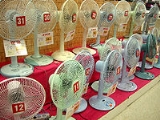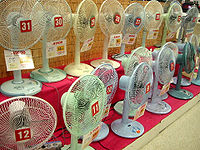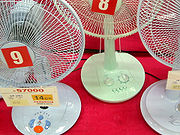
Fan death
Encyclopedia

South Korea
The Republic of Korea , , is a sovereign state in East Asia, located on the southern portion of the Korean Peninsula. It is neighbored by the People's Republic of China to the west, Japan to the east, North Korea to the north, and the East China Sea and Republic of China to the south...
that an electric fan left running overnight in a closed room can cause the death of those inside. Fans sold in Korea are equipped with a timer switch that turns them off after a set number of minutes, which users are frequently urged to set when going to sleep with a fan on.
The Korea Consumer Protection Board (KCPB), a South Korean government-funded public agency, issued a consumer safety alert in 2006 warning that "asphyxiation from electric fans and air conditioners" was among South Korea's five most common seasonal summer accidents or injuries, according to data they collected. The KCPB published the following:
If bodies are exposed to electric fans or air conditioners for too long, it causes [the] bodies to lose water and [causes] hypothermia. If directly in contact with [air current from] a fan, this could lead to death from [an] increase of carbon dioxide saturation concentration [sic] and decrease of oxygen concentration. The risks are higher for the elderly and patients with respiratory problems. From 2003 [to] 2005, a total of 20 cases were reported through the CISS involving asphyxiations caused by leaving electric fans and air conditioners on while sleeping. To prevent asphyxiation, timers should be set, wind direction should be rotated and doors should be left open.
Despite warnings from the media and other agencies in South Korea, it seems it has never been explained by these organizations why this phenomenon has never been reported or ever heard of in any other country including North Korea.
Origins
The genesis of this belief system in South Korea remains a mystery although there are some theories as to the origin. The most prevalent theory is that since the first reports of fan death didn't occur until the 1970's, it is speculated that in order to conserve energy use by the population, the South Korean government propagated this notion in order to cut down on energy usage at a time of supply constraints.Beliefs
The specifics behind belief in the myth of fan-death often offer several explanations for the precise mechanism by which the fan kills. However, as explained below, none of these beliefs stands up to logical or scientific scrutiny. Examples for possible justifications of belief in fan death are as follows:- That an electric fan creates a vortexVortexA vortex is a spinning, often turbulent,flow of fluid. Any spiral motion with closed streamlines is vortex flow. The motion of the fluid swirling rapidly around a center is called a vortex...
, which sucks the oxygenOxygenOxygen is the element with atomic number 8 and represented by the symbol O. Its name derives from the Greek roots ὀξύς and -γενής , because at the time of naming, it was mistakenly thought that all acids required oxygen in their composition...
from the enclosed and sealed room and creates a partial vacuumVacuumIn everyday usage, vacuum is a volume of space that is essentially empty of matter, such that its gaseous pressure is much less than atmospheric pressure. The word comes from the Latin term for "empty". A perfect vacuum would be one with no particles in it at all, which is impossible to achieve in...
inside. Indoor fans are not nearly powerful enough to change the air pressure by any significant amount. Additionally if the room is closed, the gases circulate only inside the room, not changing overall pressure with respect to the environment. - That an electric fan chops up all the air particles in the air leaving none to breathe. This explanation violates mass conservation and well-known properties of moleculeMoleculeA molecule is an electrically neutral group of at least two atoms held together by covalent chemical bonds. Molecules are distinguished from ions by their electrical charge...
s and gasGasGas is one of the three classical states of matter . Near absolute zero, a substance exists as a solid. As heat is added to this substance it melts into a liquid at its melting point , boils into a gas at its boiling point, and if heated high enough would enter a plasma state in which the electrons...
es, particularly that known breakdown energy of oxygen molecules lies in the ultravioletUltravioletUltraviolet light is electromagnetic radiation with a wavelength shorter than that of visible light, but longer than X-rays, in the range 10 nm to 400 nm, and energies from 3 eV to 124 eV...
range, far above the energy produced by a fan. Furthermore, atomic oxygen is highly reactive and would produce sharp-smelling ozoneOzoneOzone , or trioxygen, is a triatomic molecule, consisting of three oxygen atoms. It is an allotrope of oxygen that is much less stable than the diatomic allotrope...
, if it was produced by some mechanism. The theory makes no justifications for how and why a person will not suffocate while awake in a room which contains an operating fan. - The fan uses up the oxygen in the room and creates fatal levels of carbon dioxide. An electric motor does not function by combustion; unlike a candleCandleA candle is a solid block or cylinder of wax with an embedded wick, which is lit to provide light, and sometimes heat.Today, most candles are made from paraffin. Candles can also be made from beeswax, soy, other plant waxes, and tallow...
, the electric motorElectric motorAn electric motor converts electrical energy into mechanical energy.Most electric motors operate through the interaction of magnetic fields and current-carrying conductors to generate force...
consumes energy supplied by the electricity, not from a fuel. The fan motor's commutatorCommutator (electric)A commutator is a rotary electrical switch in certain types of electric motors or electrical generators that periodically reverses the current direction between the rotor and the external circuit. In a motor, it applies power to the best location on the rotor, and in a generator, picks off power...
does produce a small amount of ozoneOzoneOzone , or trioxygen, is a triatomic molecule, consisting of three oxygen atoms. It is an allotrope of oxygen that is much less stable than the diatomic allotrope...
during normal operation; however, most AC powered fans use induction motors, whose brushless design eliminates any possible ozone production. Ozone can be fatal in high concentrations, but under normal conditions the gas would never build up to lethal levels.

- That if the fan is put directly in front of the face of the sleeping person, it will suck all the air away, preventing one from breathing. Bernoulli's principleBernoulli's principleIn fluid dynamics, Bernoulli's principle states that for an inviscid flow, an increase in the speed of the fluid occurs simultaneously with a decrease in pressure or a decrease in the fluid's potential energy...
states that as air speed increases, air pressure decreases, meaning less air to breathe, but this effect would not be anywhere near dramatic enough to kill a person. Additionally, the resultant pressure gradient would yield flow from the high pressure surrounding area to the low pressure area, largely nullifying this effect. - That fans contribute to hypothermiaHypothermiaHypothermia is a condition in which core temperature drops below the required temperature for normal metabolism and body functions which is defined as . Body temperature is usually maintained near a constant level of through biologic homeostasis or thermoregulation...
, or abnormally low body temperature. As the metabolism slows down at night, one becomes more sensitive to temperature, and thus supposedly more prone to hypothermia. If the fan is left on all night in a sealed and enclosed room, believers in fan death suppose that it will lower the temperature of the room to the point that it can cause hypothermia. Empirical measurements will show, however, that the temperature in the room does not fall, at least not due to the fan; if at all, it should rise slightly because of friction and the heat output of the fan motor, but even this is generally not significant. Fans actually make one cooler by increasing the convectionConvectionConvection is the movement of molecules within fluids and rheids. It cannot take place in solids, since neither bulk current flows nor significant diffusion can take place in solids....
around a person's body so that heat flows from them to the air more easily, and by the latent heat of vaporization as perspiration evaporates from the body. However, there is no scientific study which indicates that this effect would be sufficient to cause hypothermia unless the temperature were already very low. Furthermore, discomfort will always wake a person long before they succumb to hypothermia. - The fan overheats after it has been left on for too long, and ceases to cool the room, instead causing the already sweltering heat to increase uncontrollably until the person dies from it. The rational explanation is that during extreme heat waves, a number of people are going to succumb to it (older or sick people), and the existence of a running fan in the room they have died in is merely circumstantial.
- That a significant part of breathing occurs through the skin (false), and that the fast moving air from a fan makes "skin breathing" more difficult.
- That fans contribute to prolonged asphyxiation due to environmental oxygen displacement or carbon dioxide intoxication. In the process of human respiration, inhaled fresh air is exhaled with a lower concentration of oxygen gas (O2), and higher concentration of carbon dioxide gas (CO2), causing a gradual reduction of O2 and buildup of CO2 in a completely unventilated room. Other indoor sources of carbon dioxide include burning fossil fuels, such as a gas-fueled water heater, and seepage through foundations in areas of high CO2 soil content. Carbon dioxide is a colorless, odorless gas, and because it weighs 1.5 times more than normal air, it tends to concentrate toward the floor, depending on temperature and air currents. In South Korea, some people sleep on traditional floor mats, called yos, while others prefer western-style beds, and floor vents may be absent when ondolOndolAn ondol, also called gudeul, in Korean traditional architecture, is underfloor heating which uses direct heat transfer from wood smoke to the underside of a thick masonry floor...
radiant underfloor heatingUnderfloor heatingUnderfloor heating and cooling is a form of central heating and cooling which achieves indoor climate control for thermal comfort using conduction, radiation and convection...
is employed. According to The Straight Dope website run by the Chicago Reader newspaper, asphyxiation is an unlikely cause of fan death because "few rooms are totally sealed, and the fan would tend to keep CO2 and other gases well mixed."
Media coverage
In summer, mainstream Korean news sources regularly report on cases of fan death. A typical example is this excerpt from the July 4, 2011, edition of The Korea Herald, an EnglishEnglish language
English is a West Germanic language that arose in the Anglo-Saxon kingdoms of England and spread into what was to become south-east Scotland under the influence of the Anglian medieval kingdom of Northumbria...
-language newspaper:
Published professional opinion
Gord Giesbrecht, a professor of thermophysiology at the University of ManitobaUniversity of Manitoba
The University of Manitoba , in Winnipeg, Manitoba, Canada, is the largest university in the province of Manitoba. It is Manitoba's most comprehensive and only research-intensive post-secondary educational institution. It was founded in 1877, making it Western Canada’s first university. It placed...
, is a leading expert on hypothermia:
Dr. John Linton at Yonsei's Severance Hospital, who attended medical school at Yonsei University
Yonsei University
Yonsei University is a Christian private research university, located in Seoul, South Korea. Established in 1885, it is one of the oldest universities in South Korea, the top private comprehensive universities in South Korea, and is widely regarded as one of the top three comprehensive...
, is licensed to practice medicine in South Korea:
Dr. Lee Yoon-song is a professor at Seoul National University
Seoul National University
Seoul National University , colloquially known in Korean as Seoul-dae , is a national research university in Seoul, Korea, ranked 24th in the world in publications in an analysis of data from the Science Citation Index, 7th in Asia and 42nd in the world by the 2011 QS World University Rankings...
's medical school and works with the school's Institute of Scientific Investigation. He has conducted autopsies on some of the people who have been described in Korean media as having succumbed to fan death:
- He blames the Korean mediaSouth Korean mediaThe South Korean media consist of several different types of public communication of news: television, radio, cinema, newspapers, magazines, and Internet-based Web sites.Modern Korean journalism began after the opening of Korea in late 19th century...
for the persistence of the urban legend:
Dr. Laurence S. Kalkstein, Research Professor of Geography and Regional Studies at Miami University
Miami University
Miami University is a coeducational public research university located in Oxford, Ohio, United States. Founded in 1809, it is the 10th oldest public university in the United States and the second oldest university in Ohio, founded four years after Ohio University. In its 2012 edition, U.S...
, however, has suggested that seniors may die from heart attack or stroke caused by the use of fans in an enclosed environment. JoongAng Ilbo
JoongAng Ilbo
JoongAng Ilbo is a conservative newspaper published in Seoul, South Korea. It is one of the "big three newspapers" in South Korea. It has a circulation of 1.96 million copies in South Korea . Its average page count per copy is around 52...
quoted him who said:
See also
- Culture of South Korea
- Urban legendUrban legendAn urban legend, urban myth, urban tale, or contemporary legend, is a form of modern folklore consisting of stories that may or may not have been believed by their tellers to be true...
s - List of common misconceptions
- Fan Death as Popular Culture (t-shirt)

